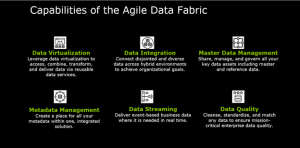TIBCO Data Fabric: What & Why
Traditional data integration can no longer satisfy the new business demands of real-time connectivity, automation, self-service, and data-driven ROI. Most organizations have trouble integrating, processing, curating, and transforming data from many sources. As a result, many businesses are placing themselves at risk by querying data from silos.
“As data grows empirically, challenges multiply exponentially”
Previously, the goal of the analytics team was to manage data and generate insights from it. With time, the emphasis shifted from simply reporting on data to being able to draw predictions from it. This is exactly why you need Data Fabric in place – rest assured that your data’s quality, availability, and reliability are not split in silos. Your data is managed inside a simple logic layer that helps you maintain, govern, simplify and accelerate your analytics.
What is DATA FABRIC?
A data fabric is a modern, distributed data architecture that comprises shared data assets and optimized data fabric pipelines for addressing today’s data concerns in a unified manner. More data sources, greater silos, more complexity, and rapid change are no longer a problem with data fabric in place – end-to-end data integration and management solution for enterprises that includes architecture, data management, integration software, and shared data. A data fabric gives each member of the organization a unified, consistent user experience and real-time access to data.
Data fabric can assist you to:
- Empower your employees.
- Streamline your procedures.
- Save time and money.
- Accelerate the realization of value.
- Enhance confidence in governing and complying.
- Take advantage of technological advancements.
- Increasing the efficiency and accuracy of your data-driven business.
Data Fabric as a Solution
Data fabric is envisioned to assist organizations in managing their data to solve complicated data problems and use cases, regardless of the numerous types of applications, platforms, or places where the data is kept.
In a distributed data environment, data fabric provides frictionless access and data sharing. This gives businesses a competitive advantage by allowing them to better satisfy client expectations, modernize their systems, and use cloud computing to their advantage.
It’s critical that businesses take advantage of the huge volumes of data they have access to gain unique insights. Forecasting, sales, supply chain optimization, marketing, and consumer behavior are just a few of the areas that give the company a competitive advantage and data leadership in its business. Moreover, real-time insight extraction can set your company apart from the competition.
“With an agile, modern infrastructure, you can unify your data.”
Components of Data Fabric
Master Data Management Data Integration
Data Virtualization Metadata Management
Data Streaming Data Quality

Implementation Highlights
Implementing data fabric is a journey that takes time and effort. The following are requirements for a successful data fabric implementation:
Application and services: This is where the data acquisition infrastructure is constructed. This includes creating apps and graphical user interfaces (GUIs) for customers to utilize while interacting with the company.
Integration and evolution of ecosystems: Creating the essential infra for data collection, management, and storage. Customer data must be sent to the data manager and storage systems in a secure manner to avoid data loss.
Security: All data gathered from various sources must be maintained with care.
Storage management: Data is kept in a way that is both accessible and efficient, with the ability to scale as needed.
Transport: Building the necessary infrastructure for data access from wherever in the organization’s geographic regions.
Endpoints: Creating software-defined infrastructure at storage and access points to enable real-time analytics.
Benefits of DATA FABRIC
Enterprises generate data continuously with any and every activity performed by any user within the ecosystem as well as accumulate data from external sources. As this data continues to rise in leaps and bounds, and infrastructure to manage it is required.

Data fabric is most suited for enterprises with a global footprint, many data sources, and complicated data concerns or use cases. Remember that a data fabric is not a quick fix for data integration and processing. Data fabric offers benefits that include:
- Scalable analytics with minimal disruption.
- Eliminate the need for exorbitantly expensive infra or highly skilled and expensive personnel.
- Works with all operating and storage systems
- A flexible approach that accommodates system changes adapts, and adjusts as needed.
- Retaining maximum integrity and regulatory compliance while maintaining accessibility and real-time information flow.
- It has a wider range of use cases, solutions, and processes than another tech.
- Business users, application engineers, data users, engineers, architects, and stewards can all benefit from it.
Start Your Journey Today
With AmtexBI, start with your data fabric vision and strategy while tackling some of the biggest challenges in your data environment and simultaneously nailing some of your biggest analytics goals. We will help you prioritize your most imperative business requirements, conduct a data management and integration gap analysis, and use data virtualization to your advantage.
This way you can organize your business agility and productivity while standardizing your access to shared data assets. AmtexBI has a deep partnership with TIBCO and we’re gearing up for our next webinar where we’re about to showcase exactly that.
If anyhow you missed it or are interested in having the entire scoop on TIBCO Data Fabric, the webinar – “DATA FABRIC FOR THE MODERN ENTERPRISE” recording is now available.
Please email us at marketing@amtexsystems.com to access the webinar recording!!
- AmtexBI
- Dataarchitecture
- Datachanges
- Datafabric
- Datafabricforthemodernenterprise
- dataintegration
- dataquality
- datastreaming
- DataVirtualization
- masterdatamanagement
- metadatamanagement
- modernenterprise
- TIBCO





